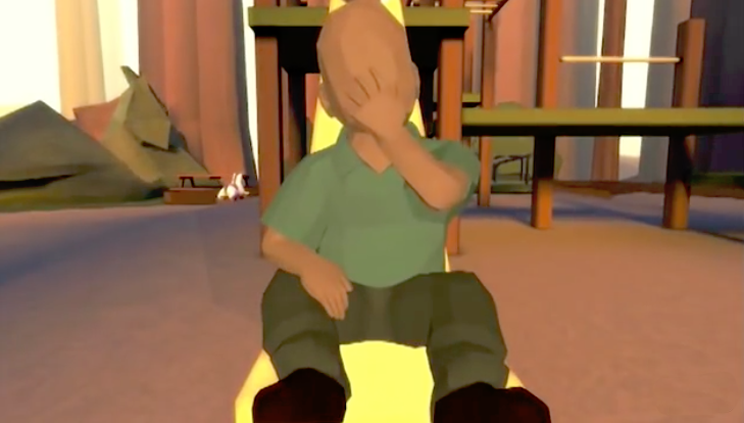Hail divinest Melancholy,
Whose Saintly visage is too bright
To hit the Sense of human sight;John Milton, Il Penseroso
Ryan and Amy Green were a young devout Christian couple from Colorado, US with three beautiful kids. Their near perfect world was shaken when their third child Joel, was diagnosed with a rare cancer just after his first birthday. Joel went on to live for about four years with lots of emotional ups and downs for the family. As one could imagine, there were lots of moments with lot of trauma and pain.

On one such evening Ryan was with baby Joel in the hospital. Joel was dehydrated and had severe diarrhea. Joel was crying out loud in intense pain and anything Ryan would do to soothe him wouldn’t work. For the entire night, Ryan made every possible effort to calm his son down. Finally in the hours of the dawn, Ryan broke down into a prayer. Joel stopped crying.
Ryan, a videogame programmer found this entire experience to be something like a game, where you keep using different tools but nothing works. Ryan and Amy put together their best efforts and savings and made a wonderful video game experience called, ‘That Dragon, Cancer’. The whole story of Green family’s pain, trauma and how it was expressed in form of a video game, has been captured by numerous articles, radio shows and even a documentary movie.
However, one question it left in my mind was, “Does pain cause creativity?” A very personal and profound trauma led to something as creative as a video game .
If we look at the history of art and artists we see that many artists did their most creative work during the most painful phase of their lives
If we look at the history of art and artists we see that many artists did their most creative work during the most painful phase of their lives . Does pain help in being creative? Let’s see what science says. Modupe Akinola from Columbia University has found that negative moods actually lead to higher degree of creativity. In her experiments she triggered negative or positive moods by negative or positive feedback respectively to a task and then asked students to engage in a creative activity.
Joseph Fargas, of University of New South Wales, has conducted a series of studies exploring the relationship between negative mood and creativity. His work has suggested that negative moods help an individual in a variety of ways. For example, a negative mood improves focus and that’s why it helps individual notice and remember better. At the same time, negative mood reduces stereotyping and other similar biases. Negative moods also at times help individuals persevere more at a given task by enhancing motivation of the person.
Katherine Sherwood, an American artist, suffered a major stroke in 1997 at the age of 44. She suffered a cerebral hemorrhage affecting the left side of her brain. Because of which her right side was paralyzed. She lost her ability to walk, talk, read and of course paint. Katherine learnt to paint using the left hand. In fact according to some neuroscientist, the damage to her brain actually helped her work.
In her own words, “It was postulated by several neuroscientists that the “interpreter” in my brain was severely damaged during my CVA. This has had a profoundly liberating effect on my work. Whereas my pre-stroke period had the tendency to be over-intellectualized and forced, my post-stroke art is less self-conscious, more urgent and expressive… In my practice as an artist, my stroke is a challenge and an opportunity rather than a loss.”
It seems that trauma or pain helps creativity in two distinct ways. First, is the psychological benefits that come as the research suggests. On the other hand, as we see in Katherine’s work, personal tragedy can be the very muse a creative individual is looking for .
Shahbuddin Rathod, a famous Indian humorist was once interviewed by Khaleej Times of Dubai, the interviewer asked him, “How to become a humorist?” He answered, ‘If you want to be a humorist, first show me your tears’. Quite often, it’s very plight of life that becomes source for creative work .
The play ‘Long Day’s Journey into Night’ talked about real-life situation in Eugene O’Neill’s life around 1912. When the play was completed it ended up becoming a mirror image of a lifetime of plight. The play was so painful for him that in his will, he prohibited any stage adaptation of the play, not only during his lifetime but for 25 years after his death. (However three years after his death his wife Carlotta Monterey had allowed to stage the play.)
Eugene O’Neil’s son in law Charles Chaplin (about which Mr. O’Neil was never quite happy) narrates a very interesting incident in his autobiography. When Chaplin was a kid, a little lamb escaped a butcher and started running amok in the street. The lamb was causing a havoc, stumbling on things, running into houses, messing up with people walking around. This scene created laughter. Everyone was laughing at this chaos. But Chaplin says that deep down, it was a tragic moment. An innocent animal was trying to save its life. It was comedy coming straight from the womb of pain.
Pain makes everything human. It makes one empathize with others. And empathy is the greatest gift for creativity
That’s what pain does. It makes everything human. It makes one empathize with others. And empathy is the greatest gift for creativity. Or as the great John Keats has said, “Do you not see how necessary a world of pains and troubles is to school an intelligence and make it a soul?”



I agree with Dr. Mehta
Some time ago, an artist told me that the creation process was painful for him… So I wonder what is the order: pain and creativity or creativity and pain?
In addition, how to link this concept with management issues, I mean, have you reached any conclusions on what this fact can help companies to push creativity?
Thanks a lot. Pranam. Writing this post reminded me of how Manuba started writing wonderful poetry and also started composing it after Dada’s demise.
Thanks for your observations Thomas. It’s a very interesting question. In my opinion, a company can help its employees become more empathetic and also help them connect better with their emotions. A workplace should not be a place to suppress emotion, rather it should be a place where an employee can truly sublimate its emotions into something productive. Let the work have therapeutic effect on people’s emotional selves.
Studies of narrative in its broadest sense not only deepen our understanding of pain and suffering, but also teach us about meaning, motivation, and discourse as represented in the biomedical, human, and social sciences.
This paragraph is really amazing . Thanks The play ‘Long Day’s Journey into Night’ talked about real-life situation in Eugene O’Neill’s life around 1912. When the play was completed it ended up becoming a mirror image of a lifetime of plight. The play was so painful for him that in his will, he prohibited any stage adaptation of the play, not only during his lifetime but for 25 years after his death. (However three years after his death his wife Carlotta Monterey had allowed to stage the play.)
Pain forces us to find strength we never knew we possessed. Being introduced to this side of ourselves certainly enables us to think more creatively as the experience expands our horizons. Why do you think some people are unable to find creativity through their pain whereas others use it as motivation to achieve greatness?
Wow, its an amazing article. It shows the mindset of the people and how to turnaround and show positivity in the paining moments. It’s key to not to loose focus and concentrate
Awesome Article – Kandarp Mehta you are a good writer and cancer is Really really bad Disease.
I Saw Cancer patients. I know the cancer pain. Nice article..